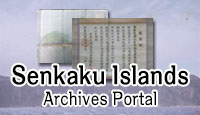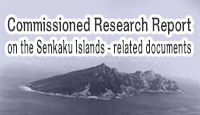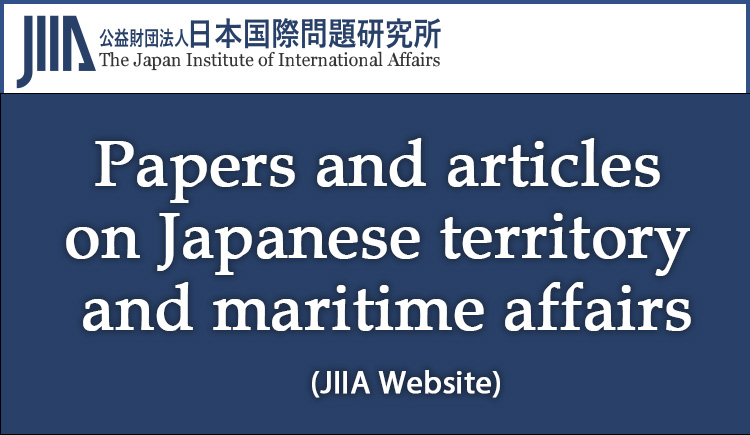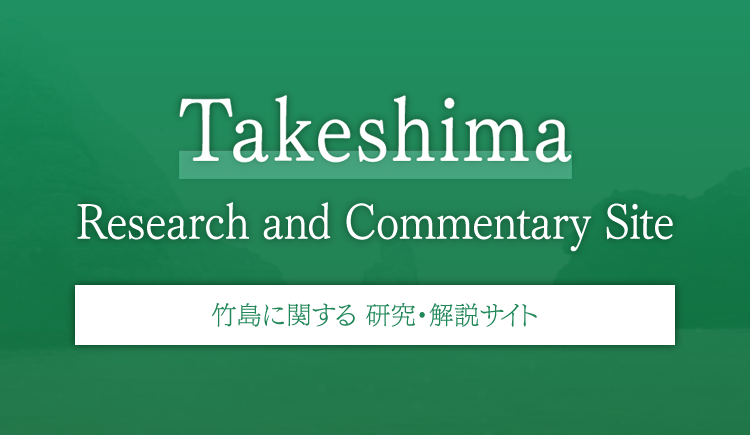The documents and materials published on this website were collected, researched, and prepared with advice from experts, as a part of a Government-commissioned project. The contents of this website do not reflect the views of the Government. Links to external sites (domains other than https://www.cas.go.jp) are not under the management of this site. For linked websites, please check with the organization/group that manages the website for the link in question.
Analysis of claims by other countries
Column How were the waters and islands of Senkaku used in premodern times?
Satoshi Hirano (Professor, The University of Tokyo Faculty of Law)
*Adobe Acrobat Reader DC, provided by Adobe, is needed to view the PDF files. If you do not have the software, please download it from the linked site. Adobe Acrobat Reader DC
1. The Ming and Qing Dynasties, and Taiwan
Until the 19th century, the Senkaku Islands located north of Ishigaki Island were islands that the people travelling in the open seas between Ryukyu and China depended upon as navigation markers. Boat captains and others sailing in the ocean, heading for Naha or Fuzhou in China, would feel that they had completed half of their voyage when the Senkaku Islands came into view.
To begin with, it is not uncommon for people speaking different languages to use different proper nouns for the same geographical location. Accordingly, in history books from the Ming and Qing Dynasties, which are successive dynasties of China, the present-day islands of Senkaku were referred to as Diaoyu Yu, Chiwei Yu, Huangwei Yu (Uotsuri Island, Kuba Island, and Taisho Island respectively). These islands were certainly depicted in maps appended to papers on the defense of the sea, which were written with an acute consciousness of the Japanese pirates of the time, as well as reports written by envoys of the emperor (sapposhi, who were accredited Chinese envoys sent to neighboring kingdoms) sent to the Ryukyus.
However, the Ming and Qing Dynasties did not necessarily achieve any domination over islands that were located far from the continent, including the Senkaku Islands. To begin with, even their domination of Taiwan took place in a relatively new era. From the later part of the Ming Dynasty to the 17th century, Taiwan, once known as Keelung Yu, was home to an Austronesian-speaking people known as the indigenous people of Taiwan today (culturally contiguous with the Philippines, Malaysia, and Indonesia). The Chinese-speaking people (Han Chinese) who make up the majority in Taiwan today had crossed over from the mainland and began living in Taiwan about 400 years ago, from around the 17th century. During the mid-17th century, the western part of Taiwan was occupied by the Netherlands. Furthermore, for about 20 years in the second half of the 17th century, Zheng, who continued to pledge allegiance to the Ming Dynasty even after its fall, escaped to Taiwan and took control of it. It was only after the end of the 17th century, during the years of the Emperor Kangxi in the Qing Dynasty, when a dynasty regarded as legitimate by present-day China finally gained control over the western part of Taiwan.
Thereafter, the Qing Dynasty gradually extended its power from the 18th century to Yilan County in the northernmost part of eastern Taiwan. However, with regard to present-day Hualien County and Taitung County, which are separated by the mountain range that runs from north to south across Taiwan, the Qing Dynasty was unable to extend control over these regions even into the second half of the 19th century as they were separated by precipitous mountains and rough seas. Even in the eastern part of Taiwan, as long as the legitimate dynasty of China did not become involved, the Senkaku Islands were never ruled by the Qing Dynasty in reality, even though their existence as navigation markers floating in the ocean far from Taiwan was known by people navigating the seas.
2. Japanese pirates, and defense of the seas in premodern times
Against this backdrop, sailors from the Ryukyus as well as wako, which were pirate organizations composed primarily of Japanese sailors and local clans, were the most active in the waters around the Senkaku Islands.
If we were to consider how the Ming and Qing Dynasties attempted to deal with these Japanese pirates, coupled with the realities of the domination of Taiwan discussed earlier, we can understand the attitude of the Ming and Qing Dynasties toward the seas.
For example, if we were to analyze books on military tactics written in the Ming Dynasty, such as Chouhai Tubian (Chukai Zuhen in Japanese) and Wubei Zhi (Bubishi in Japanese), we would see that it was common practice for the authorities of provinces such as Zhejiang and Fujian, which came under attacks by the Japanese pirates, to defend the seas along the coastal regions of the mainland. In particular, in confronting the pirates, they adopted the tactic of drawing the pirates into the mouth of a bay facing a mainland city, then intercepting them using fortresses built on land. Conversely, the idea of cracking down on pirates by sending warships out to the open sea was excluded from consideration for reasons such as how rough the seas were, inefficiency of maritime security due to the vast expanse of the sea, and the risk of running aground on reefs that appeared suddenly in the shallows. Hence, if we were to look at such books on military tactics, we would see highly detailed descriptions of geographical information pertaining to the coastal regions of the Chinese mainland, recorded for the purpose of intercepting attacks by Japanese pirates. However, with regard to islands located far from the mainland, these books provided no more than lists containing extremely vague information about the locations of the islands.
Islands occupying a vague space beyond the distant seas, with no expectation that officials or soldiers would be dispatched to manage them—this was the impression that the Ming and Qing Dynasties in the premodern times had of Diaoyu Yu, or the Senkaku Islands.
Hence, even if the Ming Dynasty had wanted to send an envoy to the Ryukyus on an investiture mission, it was faced with the problems of an unfamiliar voyage as well as the need to expend manpower from Fuzhou in order to make the necessary preparations. In particular, the Emperor of the Ryukyus was long-lived, so a prolonged interval between a change of emperors would mean that the experience of the previous envoy would not be passed down to the Fuzhou side, resulting in repeated difficulties and struggles. This is precisely why it was common for envoys on investiture missions to rely on the Ryukyu people—who regularly travel freely in the waters around the Senkaku Islands for trade—to serve as their main crew members below the level of the pilot (compass interpreter), when travelling between Fuzhou and Naha.
3. Ambiguous boundaries
As long as the Ming and Qing Dynasties did not conceive of the idea of managing the Senkaku Islands, the awareness of a boundary surrounding the Senkaku Islands was also extremely vague. Against this background, descriptions of a “boundary” emerged in exchanges between envoys on investiture missions and the Ryukyuan pilots and crew.
The white paper on the Senkaku issue, titled Diaoyu Dao, an Inherent Territory of China and published by China in September 2012, establishes that a clear boundary had existed between the Senkaku Islands and the Ryukyus in premodern times, based on records left by envoys on investiture missions heading to Naha, that is, the text that appears in the “reports written by Chinese imperial envoys” at the time. For example, Chen Kan’s Shi Liu Qiu Lu (Records of the Imperial Title-conferring Envoys to Ryukyu) (1534) carries an entry on how the crew members from Ryukyu wept with joy when Kume Island came into sight, while Xie Jie’s Liu Qiu Lu Cuo Yao Bu Yi (Addendum to Summarized Record of Ryukyu) (1579) as well as Shi Liu Qui Lu (Records of the Imperial Title-conferring Envoys to Ryukyu) by Xia Ziyang and Wang Shizhen (1606) contain descriptions on the appearance of a tide rip known as the “Hei Shui Gou” (“Black Water Trench”) and “Hei Shui/Cang Shui” )”Black Water/Blue Water.” Based on these accounts, the white paper asserts that there had been a clear awareness of the boundary between China and the outside world (the Ryukyus) during premodern times. On top of that, it also asserts that “These historical accounts clearly demonstrate that Diaoyu Dao and Chiwei Yu belong to China and Kume Island belongs to Ryukyu, and that the separating line lies in Hei Shui Gou (today's Okinawa Trough) between Chiwei Yu and Kume Island.”
However, there were probably no people who bore the sentiment of having returned home toward islands that were uninhabited to begin with, and which served only as navigation markers. Moreover, tide rips may not appear, or may sometimes appear in multiple numbers. In the Shi Liu Qiu Ji (Records of the Imperial Title-conferring Envoys to Ryukyu) recorded by the Qing envoy Li Dingyuan, who had travelled to the Ryukyus in 1800, he had declared that no such things as Hei Gou exist because no tide rips had appeared on his voyage. With such ambiguous geographical knowledge and natural phenomenon, it is impossible to state that a national boundary existed at a precise location. It is also impossible to equate that with the Okinawa Trough, which is a geographical feature of the seabed.
4. Modern times, with the specification of territories, territorial waters, and boundaries
From the modern times, the sovereign state was born in the Western world as an entity that is responsible for the effective dominion of land and people, and international laws that prescribe how to regulate the relationships between sovereign states were established. From the mid-19th century, as modern international relations centered around the West spread across the Asia Pacific region, Japan and the Qing Dynasty also gradually began to adopt international law. Under international law, the ocean, too, was categorized and considered in terms of the territorial waters surrounding territorial land, and international waters for non-territorial waters.
Consequently, all islands, even those that could have remained with an ambiguous status as to whom they are governed by, became problematic with regard to the country that they belong to, the scope of the territorial waters, and the question of whether or not to establish an intermediate line. Of course, for places that a number of countries assert their claim over, an international conflict would definitely arise if any one of these countries were to draw the demarcation line unilaterally. However, with regard to land that no country has claimed governance over for many years, when a country that has a strong relationship with such territory begins to manage it peacefully without opposition from other parties, international law will recognize the said country’s dominion over the land and territorial waters, or in other words, its sovereignty. Japan has had deep ties with the Senkaku Islands as its surrounding waters were used by the Ryukyu people and the people of Okinawa Prefecture. For this reason, the Meiji government officially established the Islands as Japanese territory in 1895.
Since then, the administrative authority for Okinawa Prefecture, including the Senkaku Islands, was came under the United States Civil Administration of the Ryukyu Islands for a period of time after World War II. However, Okinawa Prefecture was returned to the rule of the Japanese government in 1972, and the Senkaku Islands have also been managed consistently by the Japanese government till the present day.
Senkaku Islands
Research and Commentary Site
- I Comprehensive issues
- II Commentary on themes by historical period
- III Analysis of claims by other countries





